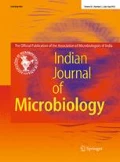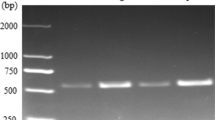Abstract
An interferon-mediated antiviral protein, 2′–5′ oligoadenylate synthetase 2, plays an important role in the antiviral response of interferons. In this study, 2′–5′ oligoadenylate synthetase 2 genes were cloned from Chinese domestic pigs. Bioinformatics analysis revealed that the 2024-bp long open reading fame encodes 707 amino acids. There are two conserved regions in this protein: the nucleotidyltransferase domain, and the 2′–5′ oligoadenylate synthetase domain (OAS). Genetic evolution analysis showed that the 2′–5′ oligoadenylate synthetase 2 gene in domestic pigs is closely related to that of cattle. There are multiple antigenic sites, no signal peptide, and no transmembrane region in the gene, which is predicted to be a hydrophilic protein. Secondary structures were found to be mainly alpha helix-based; its tertiary structure is close to that of humans and cattle, but not that of mice. Tissue distribution results indicated that this protein is distributed in multiple organs, with high distribution in the liver; it is mainly localized in the cytoplasm. PRRSV infection, interferon-beta, and Poly(I: C) treatment all promoted 2′–5′ oligoadenylate synthetase 2 gene expression. Overexpression and RNA silencing of porcine OAS2 inhibited and promoted PRRSV replication in cells, respectively. The inhibitory effect of porcine OAS2 was mainly dependent on RNase L, similar to what was predicted. This study has laid the foundation for future antiviral studies in pig, and provided a new way of preventing and treating PRRSV in the future.












Similar content being viewed by others
References
Schoggins JW, Wilson SJ, Panis M, Murphy MY, Jones CT, Bieniasz P, Rice CM (2011) A diverse range of gene products are effectors of the type I interferon antiviral response. Nature 472:481–485. https://doi.org/10.1038/nature09907
Schoggins JW, Wilson SJ, Panis M, Murphy MY, Jones CT, Bieniasz P, Rice CM (2015) Corrigendum: a diverse range of gene products are effectors of the type I interferon antiviral response. Nature 525:144. https://doi.org/10.1038/nature14554
Saunders ME, Gewert DR, Tugwell ME, McMahon M, Williams BR (1985) Human 2-5A synthetase: characterization of a novel cDNA and corresponding gene structure. EMBO J 4:1761–1768
Benech P, Mory Y, Revel M, Chebath J (1985) Structure of two forms of the interferon-induced (2′–5′) oligo A synthetase of human cells based on cDNAs and gene sequences. EMBO J 4:2249–2256
Hovanessian AG, Kerr IM (1979) The (2′–5′) oligoadenylate (pppA2′–5′A2′–5′A) synthetase and protein kinase(s) from interferon-treated cells. Eur J Biochem FEBS 93:515–526
Triozzi PL, Avery KB, Abou-Issa HM, Chou TC (1989) Combined effects of interferon and steroid hormones on 2′,5′-oligoadenylate synthetase activity in chronic lymphocytic leukemia cells. Leuk Res 13:437–443
Sokawa J, Sokawa Y (1986) (2′–5′) oligoadenylate synthetase in chicken embryo erythrocytes and immature red blood cells. J Biochem 99:119–124
Rachmilewitz D, Karmeli F, Panet A (1985) Interferon inhibits prostaglandin E2 synthesis and stimulates (2′–5′)oligoadenylate synthetase activity in peripheral blood mononuclear cells of inflammatory bowel disease patients. J Interferon Res 5:629–635
Lodemann E, Nitsche EM, Lang MH, Gerein V, Altmeyer P, Holzmann H, Kornhuber B (1985) Serum interferon level and (2–-5′)oligoadenylate synthetase activity in lymphocytes during clinical interferon application. J Interferon Res 5:621–628. https://doi.org/10.1089/jir.1985.5.621
Shimizu N, Sokawa Y (1983) (2′–5′)Oligoadenylate synthetase in pig spleen: isolation and characterization. J Biochem 94:1421–1428
West DK, Ball LA (1982) Induction and maintenance of 2′,5′-oligoadenylate synthetase in interferon-treated chicken embryo cells. Mol Cell Biol 2:1436–1443
Meurs E, Rougeot C, Svab J, Laurent AG, Hovanessian AG, Robert N, Gruest J, Montagnier L, Dray F (1982) Use of an anti-human leukocyte interferon monoclonal antibody for the purification and radioimmunoassay of human alpha interferon. Infect Immun 37:919–926
Hartmann R, Olsen HS, Widder S, Jorgensen R, Justesen J (1998) p59OASL, a 2′–5′ oligoadenylate synthetase like protein: a novel human gene related to the 2′–5′ oligoadenylate synthetase family. Nucleic Acids Res 26:4121–4128
Dong B, Silverman RH (1997) A bipartite model of 2-5A-dependent RNase L. J Biol Chem 272:22236–22242
Kumar S, Mitnik C, Valente G, Floyd-Smith G (2000) Expansion and molecular evolution of the interferon-induced 2′–5′ oligoadenylate synthetase gene family. Mol Biol Evol 17:738–750
Perelygin AA, Zharkikh AA, Scherbik SV, Brinton MA (2006) The mammalian 2′–5′ oligoadenylate synthetase gene family: evidence for concerted evolution of paralogous Oas1 genes in rodentia and artiodactyla. J Mol Evol 63:562–576. https://doi.org/10.1007/s00239-006-0073-3
Zhu J, Zhang Y, Ghosh A, Cuevas RA, Forero A, Dhar J, Ibsen MS, Schmid-Burgk JL, Schmidt T, Ganapathiraju MK, Fujita T, Hartmann R, Barik S, Hornung V, Coyne CB, Sarkar SN (2014) Antiviral activity of human OASL protein is mediated by enhancing signaling of the RIG-I RNA sensor. Immunity 40:936–948. https://doi.org/10.1016/j.immuni.2014.05.007
Al-khatib K, Williams BR, Silverman RH, Halford W, Carr DJ (2003) The murine double-stranded RNA-dependent protein kinase PKR and the murine 2′,5′-oligoadenylate synthetase-dependent RNase L are required for IFN-beta-mediated resistance against herpes simplex virus type 1 in primary trigeminal ganglion culture. Virology 313:126–135
Castelli JC, Hassel BA, Maran A, Paranjape J, Hewitt JA, Li XL, Hsu YT, Silverman RH, Youle RJ (1998) The role of 2′–5′ oligoadenylate-activated ribonuclease L in apoptosis. Cell Death Differ 5:313–320. https://doi.org/10.1038/sj.cdd.4400352
Cagliani R, Fumagalli M, Guerini FR, Riva S, Galimberti D, Comi GP, Agliardi C, Scarpini E, Pozzoli U, Forni D, Caputo D, Asselta R, Biasin M, Paraboschi EM, Bresolin N, Clerici M, Sironi M (2012) Identification of a new susceptibility variant for multiple sclerosis in OAS1 by population genetics analysis. Hum Genet 131:87–97. https://doi.org/10.1007/s00439-011-1053-2
Knapp S, Yee LJ, Frodsham AJ, Hennig BJ, Hellier S, Zhang L, Wright M, Chiaramonte M, Graves M, Thomas HC, Hill AV, Thursz MR (2003) Polymorphisms in interferon-induced genes and the outcome of hepatitis C virus infection: roles of MxA, OAS-1 and PKR. Genes Immun 4:411–419. https://doi.org/10.1038/sj.gene.6363984
Bonnevie-Nielsen V, Field LL, Lu S, Zheng DJ, Li M, Martensen PM, Nielsen TB, Beck-Nielsen H, Lau YL, Pociot F (2005) Variation in antiviral 2′,5′-oligoadenylate synthetase (2′5′AS) enzyme activity is controlled by a single-nucleotide polymorphism at a splice-acceptor site in the OAS1 gene. Am J Hum Genet 76:623–633. https://doi.org/10.1086/429391
Hamano E, Hijikata M, Itoyama S, Quy T, Phi NC, Long HT, Ha LD, Ban VV, Matsushita I, Yanai H, Kirikae F, Kirikae T, Kuratsuji T, Sasazuki T, Keicho N (2005) Polymorphisms of interferon-inducible genes OAS-1 and MxA associated with SARS in the Vietnamese population. Biochem Biophys Res Commun 329:1234–1239. https://doi.org/10.1016/j.bbrc.2005.02.101
Alagarasu K, Honap T, Damle IM, Mulay AP, Shah PS, Cecilia D (2013) Polymorphisms in the oligoadenylate synthetase gene cluster and its association with clinical outcomes of dengue virus infection. Infect Genet Evol 14:390–395. https://doi.org/10.1016/j.meegid.2012.12.021
Rios JJ, Fleming JG, Bryant UK, Carter CN, Huber JC, Long MT, Spencer TE, Adelson DL (2010) OAS1 polymorphisms are associated with susceptibility to West Nile encephalitis in horses. PLoS ONE 5:e10537. https://doi.org/10.1371/journal.pone.0010537
Bautista EM, Meulenberg JJ, Choi CS, Molitor TW (1996) Structural polypeptides of the American (VR-2332) strain of porcine reproductive and respiratory syndrome virus. Adv Virol 141:1357–1365
Rossow KD, Collins JE, Goyal SM, Nelson EA, Christopher-Hennings J, Benfield DA (1995) Pathogenesis of porcine reproductive and respiratory syndrome virus infection in gnotobiotic pigs. Vet Pathol 32:361–373
Kim HS, Kwang J, Yoon IJ, Joo HS, Frey ML (1993) Enhanced replication of porcine reproductive and respiratory syndrome (PRRS) virus in a homogeneous subpopulation of MA-104 cell line. Adv Virol 133:477–483
Benfield DA, Nelson E, Collins JE, Harris L, Goyal SM, Robison D, Christianson WT, Morrison RB, Gorcyca D, Chladek D (1992) Characterization of swine infertility and respiratory syndrome (SIRS) virus (isolate ATCC VR-2332). J Vet Diagn Invest 4:127–133
den Boon JA, Snijder EJ, Chirnside ED, de Vries AA, Horzinek MC, Spaan WJ (1991) Equine arteritis virus is not a togavirus but belongs to the coronaviruslike superfamily. J Virol 65:2910–2920
Zhao M, Wang L, Li S (2017) Influenza A virus-host protein interactions control viral pathogenesis. Int J Mol Sci. https://doi.org/10.3390/ijms18081673
Tian K, Yu X, Zhao T, Feng Y, Cao Z, Wang C, Hu Y, Chen X, Hu D, Tian X, Liu D, Zhang S, Deng X, Ding Y, Yang L, Zhang Y, Xiao H, Qiao M, Wang B, Hou L, Wang X, Yang X, Kang L, Sun M, Jin P, Wang S, Kitamura Y, Yan J, Gao GF (2007) Emergence of fatal PRRSV variants: unparalleled outbreaks of atypical PRRS in China and molecular dissection of the unique hallmark. PLoS ONE 2:e526. https://doi.org/10.1371/journal.pone.0000526
Zhou L, Wang Z, Ding Y, Ge X, Guo X, Yang H (2015) NADC30-like strain of porcine reproductive and respiratory syndrome virus, China. Emerg Infect Dis 21:2256–2257. https://doi.org/10.3201/eid2112.150360
Cavanagh D (1997) Nidovirales: a new order comprising coronaviridae and arteriviridae. Adv Virol 142:629–633
Li H, Chen X, Zhao M, Zhou E, Qiao S, Zhang G (2017) Analysis of related molecular changes of innate immune signaling pathway in porcine reproductive and respiratory syndrome virus infected PAMs. Acta Vet Zootech Sin 48:1288–1299
Zhao M, Ning Z, Wang H, Huang Z, Zhang M, Zhang G (2013) Sequence analysis of NSP9 gene of 25 PRRSV strains from Guangdong province, subtropical southern China. Virus Genes 46:88–96. https://doi.org/10.1007/s11262-012-0842-6
Zhao M, Wan B, Li H, He J, Chen X, Wang L, Wang Y, Xie S, Qiao S, Zhang G (2017) Porcine 2′,5′-oligoadenylate synthetase 2 inhibits porcine reproductive and respiratory syndrome virus replication in vitro. Microb Pathog 111:14–21. https://doi.org/10.1016/j.micpath.2017.08.011
Zhao M, Qian J, Xie J, Cui T, Feng S, Wang G, Wang R, Zhang G (2016) Characterization of polyclonal antibodies against nonstructural protein 9 from the porcine reproductive and respiratory syndrome virus. Front Agric Sci Eng 3:153–160. https://doi.org/10.15302/j-fase-2016097
Yamamoto Y, Sono D, Sokawa Y (2000) Effects of specific mutations in active site motifs of 2′,5′-oligoadenylate synthetase on enzymatic activity. J Interf Cytokine Res 20:337–344. https://doi.org/10.1089/107999000312496
Zheng S, Zhu D, Lian X, Liu W, Cao R, Chen P (2016) Porcine 2′,5′-oligoadenylate synthetases inhibit Japanese encephalitis virus replication in vitro. J Med Virol 88:760–768. https://doi.org/10.1002/jmv.24397
Naganuma A, Nozaki A, Tanaka T, Sugiyama K, Takagi H, Mori M, Shimotohno K, Kato N (2000) Activation of the interferon-inducible 2′–5′-oligoadenylate synthetase gene by hepatitis C virus core protein. J Virol 74:8744–8750
Sanchez R, Mohr I (2007) Inhibition of cellular 2′–5′ oligoadenylate synthetase by the herpes simplex virus type 1 Us11 protein. J Virol 81:3455–3464. https://doi.org/10.1128/JVI.02520-06
Zhao L, Jha Babal K, Wu A, Elliott R, Ziebuhr J, Gorbalenya Alexander E, Silverman Robert H, Weiss Susan R (2012) Antagonism of the interferon-induced OAS-RNase L pathway by murine coronavirus ns2 protein is required for virus replication and liver pathology. Cell Host Microbe 11:607–616. https://doi.org/10.1016/j.chom.2012.04.011
Dhar J, Cuevas RA, Goswami R, Zhu J, Sarkar SN, Barik S (2015) 2′–5′-Oligoadenylate synthetase-like protein inhibits respiratory syncytial virus replication and is targeted by the viral nonstructural protein 1. J Virol 89:10115–10119. https://doi.org/10.1128/JVI.01076-15
Drappier M, Michiels T (2015) Inhibition of the OAS/RNase L pathway by viruses. Curr Opin Virol 15:19–26. https://doi.org/10.1016/j.coviro.2015.07.002
Acknowledgements
Our work received funds from the Scientific Research Foundation of the Programs for Science and Technology Development of Henan Province, China (Grant No. 162102110033).
Author information
Authors and Affiliations
Corresponding author
Ethics declarations
Conflict of interest
The authors declare that they have no conflict of interest.
Rights and permissions
About this article
Cite this article
Wang, R., Ma, H., Kang, Y. et al. Molecular Cloning and Identification of the 2′–5′ Oligoadenylate Synthetase 2 Gene in Chinese Domestic Pigs Through Bioinformatics Analysis, and Determination of Its Antiviral Activity Against Porcine Reproductive and Respiratory Syndrome Virus Infection. Indian J Microbiol 58, 332–344 (2018). https://doi.org/10.1007/s12088-018-0731-3
Received:
Accepted:
Published:
Issue Date:
DOI: https://doi.org/10.1007/s12088-018-0731-3




